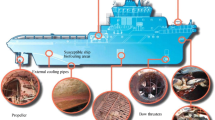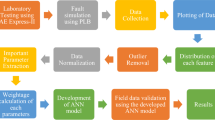Abstract
This study proposes a novel wireless guided-wave ultrasonic propagation imaging (GUPI) system to enable completely wireless inspections of structures. A conventional GUPI system consists of an excitation laser, laser mirror scanner (LMS), computer with data acquisition (DAQ) capability, bandpass filter, and sensor. While the GUPI system offers a fast scan time and a large scan area compared to other laser scanning or non-destructive testing systems, the physical wired connection of the sensor to the DAQ remains an obstacle for in situ implementation. Therefore, in this study, a wireless ultrasonic device (WUD) and peak detection-based wireless synchronization algorithm were developed for a wireless GUPI system, which eliminated the physical wired connection between the specimen and inspection system. A composite wing skin specimen was used to compare wired and wireless GUPI system measurements. The wireless inspection capability of the wireless GUPI system will improve the possibility of implementing the GUPI system for aircraft structure inspections and enhance the overall structural safety of the aircraft.








Similar content being viewed by others
Data availability
The data used to support this study are available from the corresponding author upon request.
References
Rana S, Fangueiro R (2016) Advanced composite materials for aerospace engineering: processing, properties and applications. Woodhead Publishing
Joo YS, Kim MS (2022) Fatigue life prediction of composite laminate based on stress of fiber and matrix of UD composite. Int J Aeronaut Space Sci 23(2):277–287. https://doi.org/10.1007/s42405-021-00434-3
Qing XP, Chan HL, Beard SJ, Kumar A (2006) An active diagnostic system for structural health monitoring of rocket engines. J Intell Mater Syst Struct 17(7):619–628. https://doi.org/10.1177/1045389X06059956
Kim SJ, Choi JH (2021) Comparative study for inspection planning of aircraft structural components. Int J Aeronaut Space Sci 22:328–337. https://doi.org/10.1007/s42405-020-00319-x
Farrar CR, Worden K (2007) An introduction to structural health monitoring. Philos Trans R Soc A 365(1851):303–315. https://doi.org/10.1098/rsta.2006.1928
Ahmed H, Mohsin A, Hon SC, Lee JR, Ihn JB (2021) Robotic laser sensing and laser mirror excitation for pulse-echo scanning inspection of fixed composite structures with non-planar geometries. Measurement. https://doi.org/10.1016/j.measurement.2021.109109
Hong SC, Abetew AD, Lee JR, Ihn JB (2017) Three dimensional evaluation of aluminum plates with wall-thinning by full-field pulse-echo laser ultrasound. Opt Lasers Eng 99:58–65. https://doi.org/10.1016/j.optlaseng.2016.08.010
Jeon JY, Gang S, Park G, Flynn E, Kang T, Han SW (2017) Damage detection on composite structures with standing wave excitation and wavenumber analysis. Adv Compos Mater 26(sup1):53–65. https://doi.org/10.1080/09243046.2017.1313577
Doan NV, Goo NS, Ko Y, Seo S, Chung M (2022) Design and analysis of micro-vibration isolation system for digital image correlation system-based structural health monitoring. Int J Aeronaut Space Sci 23(4):711–722. https://doi.org/10.1007/s42405-022-00455-6
Abbas SH, Truong TC, Lee JR (2017) FPGA-based ultrasonic energy mapping with source removal method for damage visualization in composite structures. Adv Compos Mater 26(sup1):3–13. https://doi.org/10.1080/09243046.2017.1313573
Choi Y, Lee JR (2018) Dual-energy wave subtraction imaging for evaluation of barely visible impact damage with an ultrasonic propagation imaging system. J Intell Mater Syst Struct 29(17):3411–3425. https://doi.org/10.1177/1045389X17721040
Park CY, Ko MG, Kim SY, Ha JS (2020) Flight test applications of an improved operational load monitoring device. Int J Aeronaut Space Sci 21:970–983. https://doi.org/10.1007/s42405-020-00270-x
Kwon H, Park Y, Shin C, Kim JH, Kim CG (2021) In-flight strain monitoring of aircraft tail boom structure using a fiber bragg grating sensor based health and usage monitoring system. Int J Aeronaut Space Sci 22:567–577. https://doi.org/10.1007/s42405-020-00324-0
Park J, Lee JR (2022) Strain measurements of an aircraft wing using embedded CNT fiber sensor and wireless SHM sensor node. Funct Compos Struct. https://doi.org/10.1088/2631-6331/ac8719
Noel AB, Abdaoui A, Elfouly T, Ahmed MS, Badawy A, Shehata MS (2017) Structural health monitoring using wireless sensor networks: a comprehensive survey. IEEE Commun Surv Tutor 19(3):1403–1423. https://doi.org/10.1109/COMST.2017.2691551
Aranguren G, Monje PM, Cokonaj V, Barrera E, Ruiz M (2013) Ultrasonic wave-based structural health monitoring embedded instrument. Rev Sci Instrum. https://doi.org/10.1063/1.4834175
Gao S, Dai X, Liu Z, Tian G (2016) High-performance wireless piezoelectric sensor network for distributed structural health monitoring. Int J Distrib Sens Netw. https://doi.org/10.1155/2016/3846804
Lee JR, Chia CC, Park CY, Jeong H (2012) Laser ultrasonic anomalous wave propagation imaging method with adjacent wave subtraction: algorithm. Opt Laser Technol. https://doi.org/10.1016/j.optlastec.2011.12.008
Acknowledgements
This work was supported by the Defense Acquisition Program Administration and the Agency for Defense Development of the Republic of Korea under grant no. 99-402-805-032 (the integration of wireless sensing into aerial vehicles for structural damage identification) and by a National Research Foundation of Korea (NRF) grant funded by the Ministry of Science and ICT (NRF-2017R1A5A1015311).
Author information
Authors and Affiliations
Corresponding author
Additional information
Publisher's Note
Springer Nature remains neutral with regard to jurisdictional claims in published maps and institutional affiliations.
Rights and permissions
Springer Nature or its licensor (e.g. a society or other partner) holds exclusive rights to this article under a publishing agreement with the author(s) or other rightsholder(s); author self-archiving of the accepted manuscript version of this article is solely governed by the terms of such publishing agreement and applicable law.
About this article
Cite this article
Park, J., Lee, JR. Development of Wireless Ultrasonic Device for Wireless Guided-Wave Ultrasonic Propagation Imaging System. Int. J. Aeronaut. Space Sci. 25, 460–467 (2024). https://doi.org/10.1007/s42405-023-00691-4
Received:
Revised:
Accepted:
Published:
Issue Date:
DOI: https://doi.org/10.1007/s42405-023-00691-4




